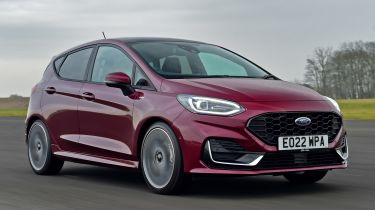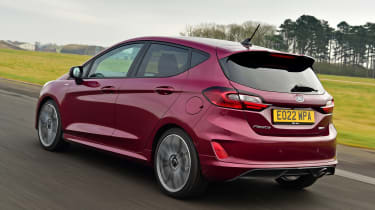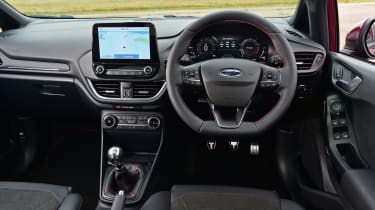New Ford Fiesta 2022 review
The big-selling Ford Fiesta has been facelifted to keep it fresh in the face of more modern opposition

Verdict
Ford’s revisions to the Fiesta are hardly revolutionary, but it doesn’t change the fact that it remains a strong contender in the supermini segment. It’s the best car in its class to drive by some margin, and it’s better equipped than ever, too. However, the lack of a full-electric option – or even a full hybrid – might limit its appeal for some buyers looking to lower their running costs as petrol prices rise.
The Ford Fiesta is small in stature, but when it comes to sales, it’s an absolute giant. It’s been at or near the top of the UK charts ever since it first arrived almost 50 years ago, and it became a permanent fixture at the head of the table when it wrestled the crown from its big brother, the Focus, in 2009.
But times change, and last year the Fiesta saw its grip on the number one spot slip into the hands of an arch-rival, the Vauxhall Corsa. Now, Ford is fighting back with a revised Fiesta – but what does it offer to help the Blue Oval reclaim its position at the top?
The first thing you’ll notice is that its fresh appeal comes from subtly revised styling. Just like the updated Focus, the Fiesta features a more prominent grille, with the Ford badge now in the centre rather than just above it. The bonnet has been reprofiled, while new headlights complement bumper tweaks below.
Used - available now

2022 Mercedes
EQA
21,343 milesAutomaticElectric
Cash £23,800
2022 Mercedes
CLA
88,049 milesAutomaticPetrol1.3L
Cash £19,300
2024 BMW
M135i
29,519 milesAutomaticPetrol2.0L
Cash £24,487
2022 Audi
A4
37,569 milesManualPetrol2.0L
Cash £15,887Seven new wheel designs freshen up an otherwise unchanged profile, and at the rear there are darker tail-lights with a new LED lighting signature.
The cabin gets a tech boost, which is most obvious in the form of a 12.3-inch digital dash, similar to the one found in the Puma. It’s bright and clear, and has a couple of customisation options, including colour and graphic changes depending on the driving mode you go for.
It’s a shame that the changes haven’t extended to the latest SYNC 4 infotainment system now found in the Focus; if Ford had stretched to that here, it would have given the Fiesta class-leading interior tech. As it stands, the previous-generation Sync 3 system is a little slicker than the tech used in the Corsa, but lacks the intuitive interface of the Hyundai i20’s, for example.
The rest of the interior is much the same as before, but it lacks the ‘wow’ factor and perceived quality of rivals from Renault and Peugeot. The layout is functional, though, and unlike some competitors, Ford has stuck with simple rotary dials for the air-con.
Interior space is unchanged. In other words, the back seats are more cramped than many of its key rivals (both in terms of head and kneeroom), including the Corsa, but especially the Clio and the Skoda Fabia. It’s a similar story with the 311-litre boot, which is a little behind the class best.
That can’t be said of the way the Fiesta drives, though. Based on a combination of handling, balance and steering precision, the Ford is comfortably ahead of any of its rivals. It turns into corners very keenly and the front end grips gamely, yet there’s enough of a sense of fun to keep even an enthusiast entertained. Not all of this will matter to a large proportion of Fiesta buyers, but the fact is it’s a genuinely enjoyable car to drive – not only by the standards of the supermini class, but by pretty much any sector – while maintaining a respectable level of day-to-day usability.
Granted, with the 18-inch alloy wheels fitted to this model the ride certainly errs on the firm, but it manages to stay on the right side of comfortable.
Best of all, you don’t have to splash out on the hot ST to put a smile on your face (although admittedly its razor-sharp chassis gives the biggest grins of all). Past experience has taught us that there’s plenty of enjoyment to be had from even the most modest petrol model.
There’s electrification on offer, but only in a limited form. While the entry-level 99bhp 1.0-litre three-cylinder turbo unit doesn’t feature mild-hybrid tech, the 123bhp version of the same unit and this 153bhp model we’re testing do.
The system recovers energy that would otherwise be wasted when slowing down, stores it in a small battery and then deploys it under acceleration to take load off the engine, therefore reducing fuel consumption. As a result, both of these hybrid units are claimed to achieve frugal numbers – in the case of this more powerful option, it’s a WLTP-confirmed figure of 52.3mpg.
In a car as compact as the Fiesta, 153bhp gives genuine warm-hatch performance; 0-62mph takes 8.9 seconds, which puts it towards the head of the supermini segment. The same engine in the Focus didn’t feel that muscular, but in the lighter Fiesta the performance is sprightly. However, before the turbo kicks in at around 2,000rpm, it still lacks a little punch. Even with a gentle level of electrical assistance, you need to give the engine more revs than you might expect in order to pull out of a junction.
When it comes to refinement, the engine gives off noticeable vibrations whether at idle or under acceleration; other three-cylinder superminis are a touch smoother.
The six-speed manual gearbox is slick, though; it’s a little heavier than a Fabia’s, but its action is precise and helps contribute towards the Fiesta’s trademark enjoyable driving feel.
What Ford’s supermini really lacks is a fully electric option. Both the Vauxhall Corsa and Peugeot 208 are offered with zero-emissions powertrains, and these have their combustion alternatives licked for smoothness, refinement and running costs – especially for company car users.
There’s been a focus on bolstering safety tech for the revised Fiesta. A ‘Wrong Way Alert’ system sees a front camera combined with the sat-nav set-up to warn a driver if they’re on the wrong side of the road, for example. There’s also a rear occupant alert.
But while there’s much that impresses, the Fiesta’s price makes this engine and trim combination hard to recommend.
With extras such as Ford’s new matrix LED headlights (£850), a panoramic roof (£995), the ‘Exclusive’ paint finish (£775) and a driver-assistance pack that adds adaptive cruise control and traffic-sign recognition for £350, our sporty ST-Line Vignale test car costs a hefty £28,135.
While some of those options are very tempting – the £425 B&O sound system is without doubt the finest you’ll get in any new supermini – that’s still an awful lot of money. It goes to show that, in this trim at least, while the Fiesta is still fun and extremely capable, it isn’t quite the affordable, attainable car it once was.
| Model: | Ford Fiesta 1.0 EcoBoost 155PS ST-Line Vignale |
| Price: | £24,440 |
| Engine: | 1.0-litre 3cyl turbo |
| Power/torque: | 153bhp/190Nm |
| Transmission: | Six-speed manual, front-wheel drive |
| 0-62mph: | 8.9 seconds |
| Top speed: | 136mph |
| Economy: | 52.3mpg |
| CO2: | 121g/km |
| On sale: | Now |










